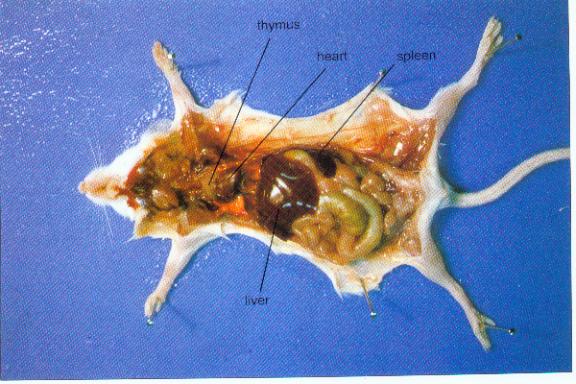The immune system protects the body from pathogens like bacteria, viruses, fungi, and parasites, and internal threats like cancer. The immune system is able to recognize invading foreign organisms, to prevent their spread, and ultimately to clear them from the body. The immune responses are orchestrated by a variety of cells. These cells circulate throughout the body and congregate in specialized lymphoid tissues. In this lab exercise, we will learn to identify the lymphoid tissues and cells of the immune system.
Lab 1. Lymphoid OrgansIn this lab exercise, you will observe a dissected mouse to locate the lymphoid organs.
A. Primary Lymphoid Organs: Organs where immune cells develop and mature to the stage at which they are able to respond to a pathogen.
Bone marrow: sites where all the cells that circulate in the blood are developed. B lymphocytes develop and mature in bone marrow.
Thymus: organ in which T lymphocytes develop and mature.
B. Secondary Lymphoid Organs: Organs where mature lymphocytes become stimulated to respond to invading pathogens.
Spleen: an organ where lymphocytes meet with pathogens from the blood. It serves as a filter for the blood and removes damaged or old red cells.
Lymph nodes: an organ where lymphocytes meet with pathogens drained from infection sites.
Mucosal associated lymphoid tissue: a general term for the unencapsulated lymphoid tissues associated with submucosal areas of the gastrointestinal, genitourinary and respiratory tracts. It includes the tonsils, the adenoids, the appendix, and the Peyer’s patches which line the small intestine.

Lymphoid organs in mouse
Lymphoid organs in human
Reading
Immunobiology 1-2 to 1-4Study Questions
1. Define the primary and secondary lymphoid organs.
2. What is the most important difference between the primary and secondary lymphoid organs?
3. Name two areas of the human body where lymph nodes can be found.
4. Where are the spleen and thymus located in mice?
5. Name all the primary and secondary lymphoid organs.